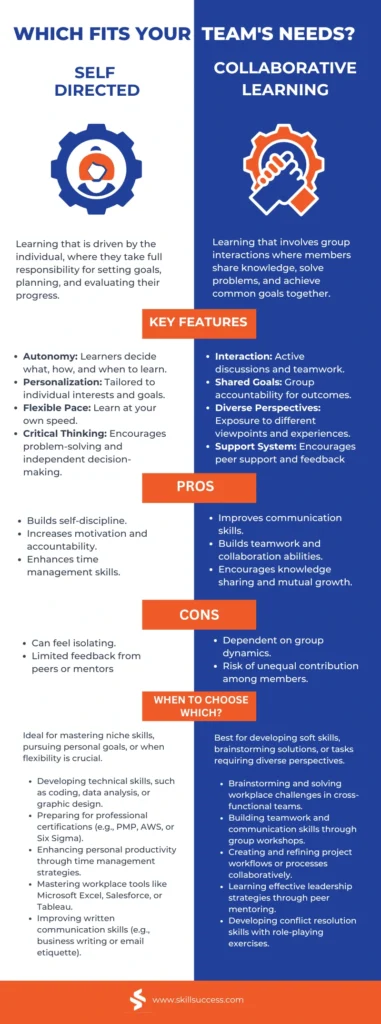Learning and development in the corporate world used to follow a one-size-fits-all approach. Training sessions were generic, and everyone was expected to learn in the same way. But times have changed. Organizations and HR leaders now recognize the need for diverse approaches to learning. Employees today are empowered to grow in two distinct ways—self-directed learning, where individuals take charge of their development, and collaborative learning, where teams come together to learn and grow. Both methods are invaluable, but how do you know which approach works best for your needs?
Here’s a quick breakdown to help you decide—and don’t forget to check out the infographic below for a visual guide.
Self-Directed Learning: Taking Charge of Growth
Self-directed learning is all about autonomy. Employees independently explore topics, set goals, and track their progress. This approach works best for mastering skills or topics that don’t require group input.
Workplace examples for self-directed learning:
- Learning industry-specific software like Salesforce or Tableau.
- Preparing for professional certifications, such as PMP or AWS.
- Enhancing time management and productivity skills.
- Strengthening business writing or email etiquette.
- Developing technical expertise like coding or data analysis.
This approach empowers employees to grow at their own pace, making it ideal for those aiming to develop niche skills or personal areas of improvement.
Collaborative Learning: Growing Together
Collaborative learning, on the other hand, thrives in group environments. It brings teams together to share knowledge, brainstorm solutions, and solve complex problems collectively.
Workplace examples for collaborative learning
- Conducting team brainstorming sessions to solve business challenges.
- Participating in group workshops to improve communication and teamwork.
- Refining workflows and processes collaboratively for better efficiency.
- Engaging in peer mentoring to develop leadership skills.
- Practicing conflict resolution through role-playing exercises.
This approach is perfect for projects requiring diverse perspectives or team alignment. It also fosters a sense of community and builds trust among coworkers.

Striking the Right Balance
Balancing self-directed and collaborative learning begins with understanding the purpose of each. Employees can use self-directed learning to master foundational skills or tools like Excel at their own pace, building confidence and expertise. Once equipped with this knowledge, they can engage in collaborative workshops or team projects, applying their skills, sharing insights, and gaining new perspectives.
To achieve this balance, organizations should encourage employees to set personal learning goals while creating opportunities for team-based activities like brainstorming sessions or group problem-solving exercises. This blend of individual effort and teamwork helps employees develop a well-rounded skill set and thrive in both independent and collaborative environments.
Infographic: Self-Directed vs. Collaborative Learning

Key Takeways
Learning in the workplace does not have to follow a one-size-fits-all approach. Leveraging both self-directed and collaborative methods allows organizations to empower employees to grow individually while fostering team success.
So, what type of learning will your team tackle next?
Stay ahead in your career with actionable insights on workplace growth, skill-building, and team dynamics!
Subscribe to our newsletter today for exclusive resources, and free tools to boost your professional development.

